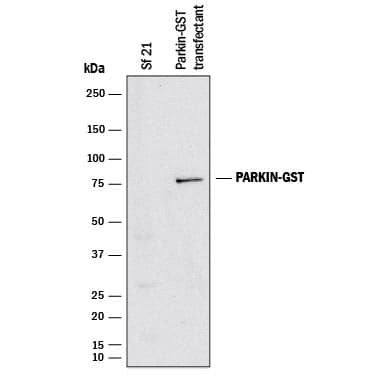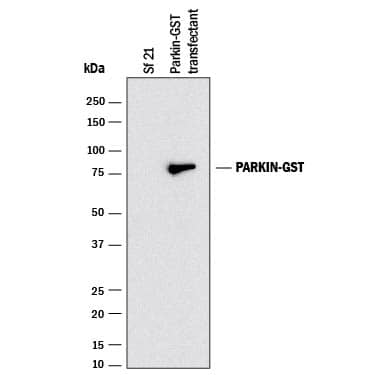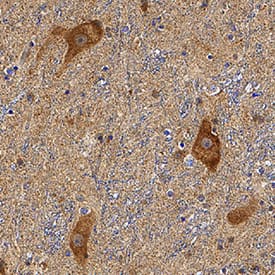Parkin Products
Parkin, also known as Parkinson Juvenile Disease Protein 2, is a 465 amino acid (aa), cytoplasmic and mitochondrial enzyme with a predicted molecular weight of 51.5 kDa, that functions as a RING-type Ubiquitin ligase (E3). Human Parkin shares 75% and 78% aa sequence identity with mouse and rat Parkin, respectively. Human Parkin2 lacks exon 5 which encodes aa 179-206 of Parkin. The structure of Parkin includes an N-terminal Ubiquitin-like motif and a C-terminal RING domain composed of two RING finger motifs separated by two IBR domains. Parkin functions in conjunction with the Ubiquitin-conjugating (E2) enzymes UbcH7, UbcH8, and Ubc13/Uev1. Together with PTEN-induced Putative Kinase 1 (PINK1), Parkin is important for maintaining functional mitochondria. Parkin is recruited to dysfunctional mitochondria in a PINK1-dependent manner, where it ubiquitinates outer mitochondrial proteins and drives autophagic degradation. Parkin is expressed in heart, testis, and skeletal muscle but is detected at the highest levels in brain. Mitochondrial dysfunction is thought to be central to the pathogenesis of Parkinsons disease (PD). This hypothesis is supported by the fact that mutations in Parkin and PINK1 result in recessive forms of the disease. Parkin is also thought to exert neuroprotective effects via regulation of the unfolded-protein stress response and targeting of various substrates for proteasomal degradation. Mutations in Parkin often affect E3 ligase activity through decreased E2 and/or substrate interactions, which result in the dysfunction of proteasomal degradation pathways and the neurotoxic accumulation of misfolded proteins.
42 results for "Parkin" in Products
42 results for "Parkin" in Products
Parkin Products
Parkin, also known as Parkinson Juvenile Disease Protein 2, is a 465 amino acid (aa), cytoplasmic and mitochondrial enzyme with a predicted molecular weight of 51.5 kDa, that functions as a RING-type Ubiquitin ligase (E3). Human Parkin shares 75% and 78% aa sequence identity with mouse and rat Parkin, respectively. Human Parkin2 lacks exon 5 which encodes aa 179-206 of Parkin. The structure of Parkin includes an N-terminal Ubiquitin-like motif and a C-terminal RING domain composed of two RING finger motifs separated by two IBR domains. Parkin functions in conjunction with the Ubiquitin-conjugating (E2) enzymes UbcH7, UbcH8, and Ubc13/Uev1. Together with PTEN-induced Putative Kinase 1 (PINK1), Parkin is important for maintaining functional mitochondria. Parkin is recruited to dysfunctional mitochondria in a PINK1-dependent manner, where it ubiquitinates outer mitochondrial proteins and drives autophagic degradation. Parkin is expressed in heart, testis, and skeletal muscle but is detected at the highest levels in brain. Mitochondrial dysfunction is thought to be central to the pathogenesis of Parkinsons disease (PD). This hypothesis is supported by the fact that mutations in Parkin and PINK1 result in recessive forms of the disease. Parkin is also thought to exert neuroprotective effects via regulation of the unfolded-protein stress response and targeting of various substrates for proteasomal degradation. Mutations in Parkin often affect E3 ligase activity through decreased E2 and/or substrate interactions, which result in the dysfunction of proteasomal degradation pathways and the neurotoxic accumulation of misfolded proteins.
Recombinant Monoclonal Antibody.
| Reactivity: | Human, Mouse, Rat |
| Details: | Rabbit IgG Monoclonal Clone #JF82-09 |
| Applications: | IHC, WB, ICC/IF, Flow, IP |
| Reactivity: | Human |
| Details: | Goat IgG Polyclonal |
| Applications: | WB, IHC |
| Reactivity: | Human, Rat |
| Details: | Mouse IgG3 Kappa Monoclonal Clone #1H4 |
| Applications: | WB, ELISA, ICC/IF |
| Source: | Sf 21 (baculovirus) |
| Accession #: | O60260.2 |
| Applications: | BA |
| Reactivity: | Human |
| Details: | Mouse IgG2a Monoclonal Clone #328122 |
| Applications: | WB |
| Source: | Sf 21 (baculovirus) |
| Accession #: | O60260.2 |
| Applications: | BA |
| Reactivity: | Human |
| Details: | Mouse IgG2b Monoclonal Clone #323302 |
| Applications: | WB |
| Reactivity: | Human |
| Details: | Mouse IgG2a Monoclonal Clone #328110 |
| Applications: | IHC |
| Reactivity: | Human, Fish - Danio rerio (Zebrafish) |
| Details: | Rabbit IgG Polyclonal |
| Applications: | IHC, WB, ELISA, ICC/IF |
| Reactivity: | Human |
| Details: | Rabbit IgG Polyclonal |
| Applications: | IHC, WB, IP |
| Reactivity: | Mouse |
| Details: | Rabbit IgG Polyclonal |
| Applications: | WB |
| Reactivity: | Human |
| Details: | Rabbit IgG Polyclonal |
| Applications: | IHC, ICC/IF |
| Reactivity: | Human |
| Details: | Rabbit IgG Polyclonal |
| Applications: | WB |
| Reactivity: | Human |
| Details: | Rabbit IgG Polyclonal |
| Applications: | WB |
| Applications: | ELISA |
| Applications: | AC |
| Applications: | ELISA |
| Reactivity: | Human |
| Details: | Rabbit IgG Polyclonal |
| Applications: | IHC, WB, ELISA, ICC/IF |
| Reactivity: | Human |
| Details: | Rabbit IgG Polyclonal |
| Applications: | IHC, WB, ELISA, ICC/IF |
| Reactivity: | Human |
| Details: | Rabbit IgG Polyclonal |
| Applications: | IHC, WB, ELISA, ICC/IF |
| Reactivity: | Human |
| Details: | Rabbit IgG Polyclonal |
| Applications: | IHC, WB, ELISA, ICC/IF |
| Reactivity: | Human |
| Details: | Rabbit IgG Polyclonal |
| Applications: | IHC, WB, ELISA, ICC/IF |
| Reactivity: | Human |
| Details: | Rabbit IgG Polyclonal |
| Applications: | IHC, WB, ELISA, ICC/IF |
| Reactivity: | Human |
| Details: | Rabbit IgG Polyclonal |
| Applications: | IHC, WB, ELISA, ICC/IF |
| Reactivity: | Human |
| Details: | Rabbit IgG Polyclonal |
| Applications: | IHC, WB, ELISA, ICC/IF |

![Western Blot: Parkin Antibody (JF82-09) [NBP2-67017] Western Blot: Parkin Antibody (JF82-09) [NBP2-67017]](https://resources.bio-techne.com/images/products/Parkin-Antibody-JF82-09-Western-Blot-NBP2-67017-img0007.jpg)


![Western Blot: Parkin Antibody (1H4) [H00005071-M01] Western Blot: Parkin Antibody (1H4) [H00005071-M01]](https://resources.bio-techne.com/images/products/Parkin-Antibody-1H4-Western-Blot-H00005071-M01-img0008.jpg)



![Western Blot: Parkin AntibodyBSA Free [NBP2-41287] Western Blot: Parkin AntibodyBSA Free [NBP2-41287]](https://resources.bio-techne.com/images/products/Parkin-Antibody-Western-Blot-NBP2-41287-img0001.jpg)
![Western Blot: Parkin Antibody [NB600-1540] Western Blot: Parkin Antibody [NB600-1540]](https://resources.bio-techne.com/images/products/p_17998_1.jpg)
![Western Blot: Parkin Antibody [NBP1-80515] Western Blot: Parkin Antibody [NBP1-80515]](https://resources.bio-techne.com/images/products/Parkin-Antibody-Western-Blot-NBP1-80515-img0003.jpg)
![Immunocytochemistry/ Immunofluorescence: Parkin Antibody [NBP2-68629] Immunocytochemistry/ Immunofluorescence: Parkin Antibody [NBP2-68629]](https://resources.bio-techne.com/images/products/Parkin-Antibody-Immunocytochemistry-Immunofluorescence-NBP2-68629-img0001.jpg)
![Western Blot: Parkin [p Ser378] Antibody [NB100-61107] Western Blot: Parkin [p Ser378] Antibody [NB100-61107]](https://resources.bio-techne.com/images/products/Parkin-[p-Ser378]-Antibody-Western-Blot-NB100-61107-img0001.jpg)
![Western Blot: Parkin [p Ser101] Antibody [NB100-61106] Western Blot: Parkin [p Ser101] Antibody [NB100-61106]](https://resources.bio-techne.com/images/products/Parkin-[p-Ser101]-Antibody-Western-Blot-NB100-61106-img0001.jpg)
![ELISA: Human Parkin ELISA Kit (Colorimetric) [NBP3-39268] Human Parkin ELISA Kit (Colorimetric)](https://resources.bio-techne.com/images/products/nbp3-39268_human-parkin-elisa-kit-colorimetric-2110202415264315.png)
![ELISA: Human Parkin - Ready-To-Use ELISA Kit (Colorimetric) [NBP3-39269] Human Parkin - Ready-To-Use ELISA Kit (Colorimetric)](https://resources.bio-techne.com/images/products/nbp3-39269_human-parkin-ready-to-use-elisa-kit-colorimetric-2110202415264320.png)
